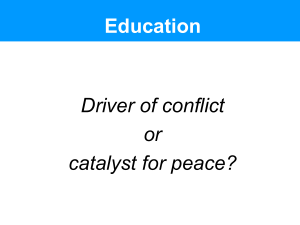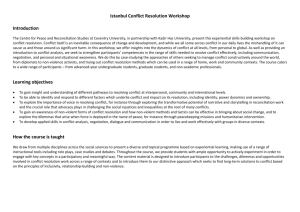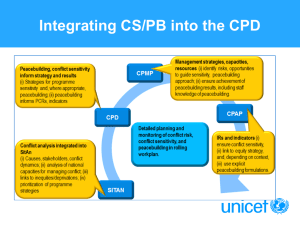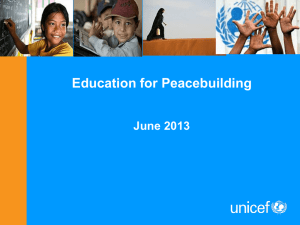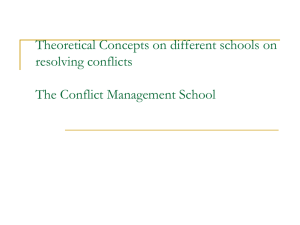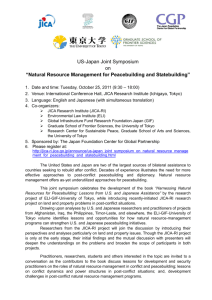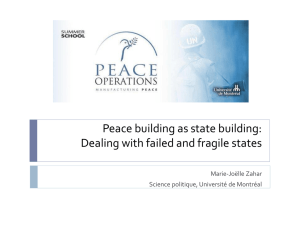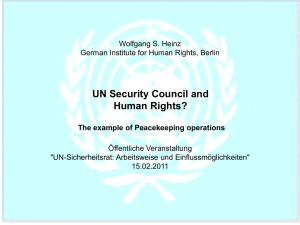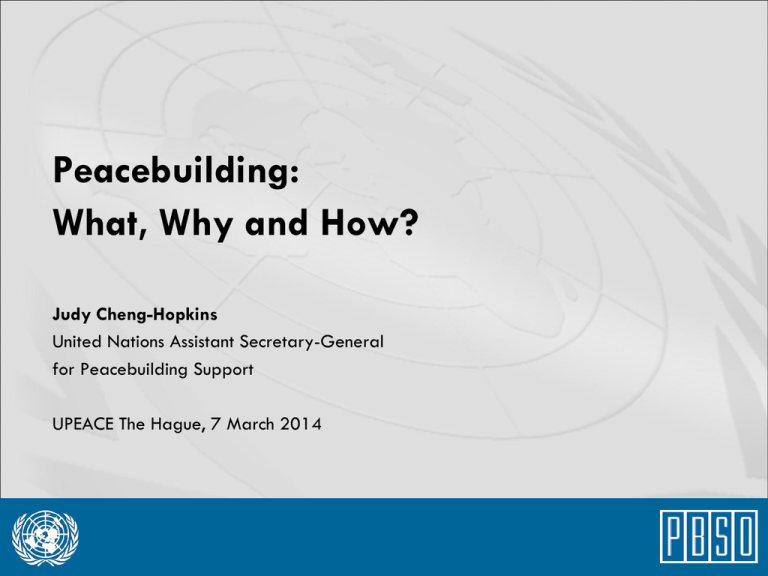
Peacebuilding:
What, Why and How?
Judy Cheng-Hopkins
United Nations Assistant Secretary-General
for Peacebuilding Support
UPEACE The Hague, 7 March 2014
Introduction
Peacebuilding in the UN context
Why is it important and what does it consist of?
The missing link?
Stages of UN involvement in post-conflict countries
SUSTAINABLE
PEACE
WAR
Humanitarian
Asst.
Peace
making
(Mediation)
Peace
keeping
Peace
building
PB important to prevent relapse and failed states
Development
Peacekeeping vs peacebuilding
Peacekeeping:
‘Blue helmets’ to help stabilize conflict areas
Some integration with wider UN efforts to revitalize economies
15 peacekeeping missions, 13 ‘special political missions,’ envoys and
special advisers
Peacebuilding:
Build longer-term sustainable peace and stability
Lay foundations for economic recovery and development
Build institutions, infrastructures and capacities
Overcome legacies and root causes of conflict
Why is Peacebuilding
Important?
Less war, fewer coups, more democracy
Democracies
1946: 20
Now: close to 100
Authoritarian regimes
1976: almost 90
Now: 25
Latin America
1970-1989:
30 coups d’etat
Since 1990:
1970-1989:
1990-2010:
99 coups d’etat
67 coups d’etat
1992:
2011:
21 countries involved in
inter-state and civil
conflict
7 countries involved in
inter-state and civil
conflict
Africa
Conflict
3 coups d’etat
Source: Centre for Humanitarian Dialogue
But the problem of state fragility persists
Conflict and war occur in countries that have previously
experienced civil war: Relapse into violence in countries that have
poor governance, weak institutions, high insecurity. Some decades
long.
They matter because they provide safe havens for terrorists
(Afghanistan, Mali, Somalia, Yemen), are major sources of drug
trafficking (Guinea-Bissau, Honduras) and other ills.
Violent conflict often recurs
The World Bank, World Development Report 2011: Conflict, Security, and Development, Table F1.1
Violence disrupts development
1.5 billion people live with violence and conflict
42 million people are displaced as result
Poverty is 20% higher in conflict countries
Countries with negligible or no violence - major decline in
poverty between 1981 and 2005; in conflict-affected
countries, poverty remained constant over the same period.
Most post conflict countries have not achieved a single MDG!
Violence slows decline in poverty
The World Bank, World Development Report 2011: Conflict, Security, and Development, Figure F1.3
A typical post-conflict country…
“Ordinary” development challenges compounded by
Decades of intermittent civil war, with relapses into violence
Military domination and/or coups
Wealth in natural resources but steep divide between small rich elite and
poor majority of the population (relapse into conflict 50% more likely in
natural resource-rich countries)
Land issues are often key drivers of conflict
Weak institutions and public services
High prevalence of corruption, limited or no rule of law and limited or no
accountability and transparency
“Vicious cycle of idle youth”
What is Peacebuilding?
Peacebuilding is a schlep
S
Safety and human security
Security sector reform (SSR), disarmament,
demobilisation and reintegration (DDR),
Rule of law, human rights…
C
Civil society
Civil society mobilisation and civic education, civilian
oversight of army
Healing
Reconciliation, mediation, transitional justice,
protection, psychosocial therapy, IDPs and
returnees/integration, SGBV, reparations
L
Livelihoods
Job creation, short-term employment generation,
youth, public works
E
Empowerment of women and
youth
Restarting economic activities, resettlement and shelter,
land reforms, natural resources,
H
P
Public administration and
accountability
Re-establishing state authority, basic services
provisions, institutions and local governance,
constitutional reform, electoral reform processes,
civil service reform, public finance management
Root causes and solutions
Simmering hatred, ethnic divisions
National Dialogue, reconciliation
Lack of understanding of
democratic norms and practices
Civic education
Sense of injustice and inequality
Rule of law, anti-corruption, human rights
Military dominance
Security Sector Reform (SSR)
Lack of civilian oversight and
accountability
Rule of law, institution-building
Former combatants left to their
own devices
Disarmament, demobilization and
reintegration (DDR)
Poverty and lack of livelihoods
Public service delivery, employment
creation, peace dividends
How?
The UN peacebuilding architecture
Established in 2005
Three pillars:
Peacebuilding Commission
Peacebuilding Fund
Peacebuilding Support Office
Peacebuilding strategic entry points
Avoiding relapse into violence (Guinea)
Protecting peacekeeping investments (Liberia, Sierra Leone)
Quick statebuilding (Yemen)
Supporting UN leadership for rapid response; deteriorating
situations (Sierra Leone)
Accompaniment: stay the course for peace (Burundi)
The missing link!
Women are the ultimate victims of conflict…
Family rupture
Change of roles:
33% of households in Rwanda headed by women in 2010.
28% of households in Nepal headed by women in 2011.
Sexual violence:
DRC: 200,000 women and children raped over a decade.
Sierra Leone: 64,000 incidents of war-related sexual violence 1991-2001.
Source: UN Action Against Sexual Violence in Conflict
… but also the ultimate “agents of change”
Women are solely responsible for 80% of food crops in developing countries,
yet less than 10% of landholders are women in Western, Central and North
Africa (FAO)
Most women spend their income to meet the needs of their family and
household – education, health, nutrition
Women play peacebuilding roles daily, typically at grassroots level - e.g.
Acholi women groups vis-à-vis the LRA in Northern Uganda
Women parliamentarians tend to emphasize issues such as physical safety
and gender-based violence, human development, poverty and the delivery
of services (IPU)
Evolution of normative
framework
SCR 1325 (2000): First to link women’s
experiences of conflict to the maintenance of
international peace and security.
SCR 1820 (2008), 1888 (2009), 1960 (2010)
and 2106 (2013) on conflict-related sexual
violence
SCR 1889 (2009): Addresses women’s
exclusion from early recovery and
peacebuilding and lack of adequate planning
and funding for their needs.
SCR 2122 (2013): Emphasizes women’s
participation in conflict resolution and recovery
and requests global study on 1325 by 2015.
The UN’s 7-Point Action Plan (7PAP)
on gender-responsive peacebuilding (2010):
1.Conflict resolution
2.Post-conflict planning
3.Post-conflict financing
4.Civilian capacity
5.Participation in Public life (30%)
6.Rule of law
7.Economic recovery
The Secretary-General has identified
the implementation of the Action Plan
as a priority for his second term.
Peacebuilding’s in-built bias
Typical peacebuilding activities - SSR, DDR, national dialogue, public
administration reform, etc. - all have men as main target.
Women are not the ones causing conflict, not the ones causing a relapse
into conflict – so peacebuilding is inherently targeting men.
Need to expand our peacebuilding paradigm to change this in-built
bias against women because invaluable role they play.
Towards a new paradigm
Four necessary changes to shift the paradigm:
1. Pre-investment: View women’s economic empowerment as a preinvestment for peacebuilding, leadership roles etc.
2. Who can do the job: Start with available capacity of implementing
partners
3. “Quotas+”: Quotas need to be supplemented by efforts to build
capacity
4. Innovation: Support innovative projects and learn from them
Start with women’s empowerment as sine qua non!
Women’s innate interest for peace
"We are tired of war. We are tired of running. We are tired of
begging for bulgur wheat. We are tired of our children being
raped. We are now taking this stand, to secure the future of our
children. Because we believe, as custodians of society, tomorrow
our children will ask us, ‘Mama, what was your role during the
crisis?’” Leymah Gbowee, Liberia, at a hearing with Charles
Taylor, April 2003.
Women are everyday peacebuilders!
Nobel Peace Prize (2011)
Women in parliaments post-conflict, first and recent elections
WITH QUOTAS
women’s participation in
parliaments post-conflict is much
higher:
1st election: 21% vs 7%
Last election: 30% vs 7.3%
When women are elected…
Rwanda: 64% women in parliament (#1 worldwide). 2012 land reform:
•
11% of the land is owned by women
•
83% of the land is joint-owned by married couples
•
6% of the land is owned by men
Burundi: 30% women in parliament collectively pushed for reform of the penal
code to include definition of sexual violence
Implementation Challenges
• Evidence base is weak – because programmatic base is weak!
• Trends of pet themes, stand alone projects, or “adding women in”
• Need for greater operational learning to understand what works. Need
to include gender in any conflict analysis and in strategic planning at
country level
• Capacities: often limited – both UN and national. Combined expertise is
required (rule of law + women’s rights; economic recovery + special
sectors)
• Lack of leadership/political support
Thank you


